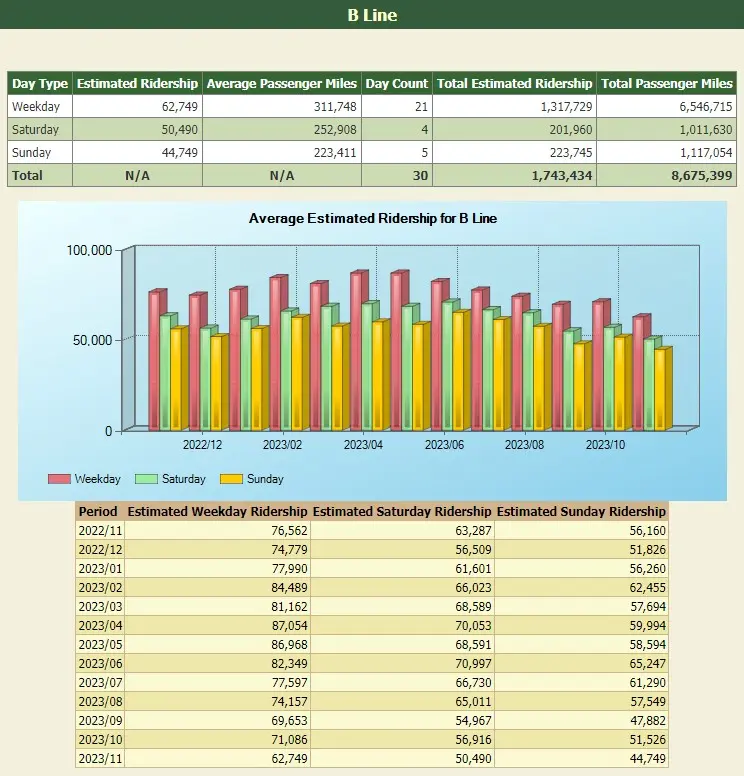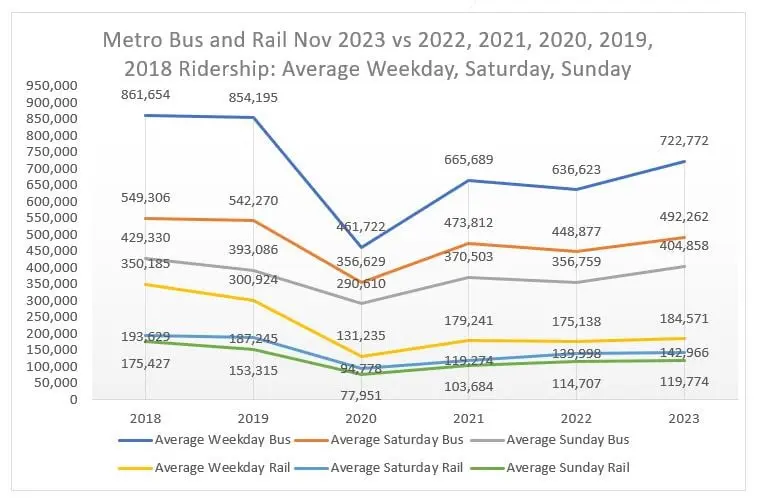Southern California transit ridership had a pretty good year. Metro ridership, recently increasing, continued its upward trends. This week, Metro released November ridership figures showing an 11.3 percent increase in total system ridership compared to November 2022.
Many Streetsblog readers know how things got here… but in brief:
- Metro cut rail and bus service in 2020, at the start of the pandemic.
- After false starts then an operator pay raise, Metro fully restored bus service in December 2022, then struggled a bit to reduce excessive bus run cancellations. Since Spring 2023, Metro has been operating full reliable bus service equivalent to pre-pandemic levels.
- In early 2023, rail service was at ~84 percent of pre-pandemic levels. In September, Metro increased heavy rail service. This month, Metro upped light rail service. The system has expanded (with new K Line and Regional Connector projects open), so overall light rail service is slightly better than pre-COVID levels.
Metro improving transit frequency and reliability is paying off. November saw more than 24 million boardings. It was the twelfth consecutive month of year-over-year ridership growth.
In calendar year 2022, Metro saw 255.3 million boardings. Through November, 2023 already saw 261.5 million. The agency expects the 2023 total to be about 285 million.
In November and December, Metro typically sees a small dip in ridership. This year, November weekday ridership was 907,343, slightly down from October’s 956,754, the highest ridership month of the pandemic era. Metro notes that November is the third consecutive month when weekday ridership exceeded 900,000 boardings.
As recently as last March, Southern California’s paper of record was reporting that commuters had “abandoned large swaths of the Metro train system.” The Times noted that Metro pre-pandemic rail ridership was lower than other big cities, and reported that as of January 2023, Gold Line and Red Line ridership was at 30 and 56 percent of pre-pandemic levels, respectively. The picture was never quite as bleak as the Times portrayed it; this is reflected even in more recent Times coverage.
But let’s take a look at Red (now B/D) Line subway ridership. Metro’s only fully-underground heavy rail, the B/D Line saw increased frequency (basically restoring pre-pandemic service levels) starting in early September.

During the pandemic, bus ridership declined less than rail. Bus ridership is also bouncing back more quickly than rail (at least partially attributable to bus service having been fully restored sooner than rail). As of October, overall Metro weekday ridership was at 80 percent of pre-COVID. Bus ridership was at 87 percent, with rail at 61 percent.
The data is a little noisy, but it also appears that Metro B/D heavy rail ridership recovery is lagging behind light rail, which lags behind bus.
B/D daily ridership plunged from ~140,000 in 2019 to around ~55,000 in 2020. For the past couple months, the B/D Line saw about 70,000 daily riders, just over half of its pre-pandemic ridership. The heavy rail line is by no means abandoned; it currently carries lots of riders – more people than any local municipal bus operator (Long Beach Transit has about 57,000 weekday riders) and more than any Metro light rail line (the newly expanded A Line now carries about 60,000 weekday riders).
Overall, it feels like the workhorse B/D heavy rail spine ridership may be sputtering. While bus and light rail have seen steady month-to-month increases (especially after service restoration), heavy rail ridership has bounced around somewhat – some months in the 80,000s, some in the 60,000s.
Metro just restored service (in September), so it’s too early to conclusively declare a trend, but while the overall Metro ridership figures are very good, it’s not clear if this is true for heavy rail.
Why the apparent lag? The B/D Line is perhaps the most suburb-to-downtown Metro line, so it could be most impacted by more folks working remotely. It’s also Metro’s the most underground line, perhaps making it bear a bigger share of unhoused Angelenos seeking shelter. Since May, some former B/D Line rides likely shifted to Regional Connector rides.

Overall, Metro’s 2023 ridership recovery is impressive. Every day, nearly a million Angelenos count on Metro to provide frequent reliable transit. Those ridership numbers grew steadily throughout 2023, and will likely return to more than a million weekday daily riders by early 2024.
